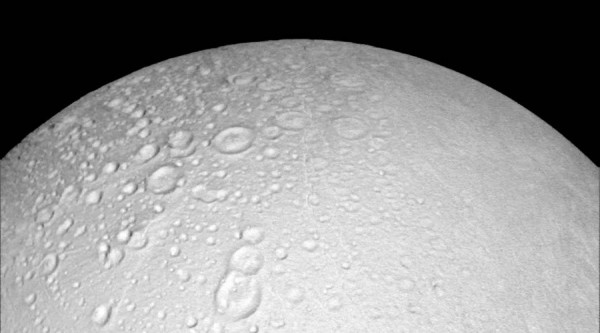NASA Releases Astonishing Photos of Saturn's Moon Enceladus
| Charissa Echavez | | Nov 01, 2015 09:51 AM EST |
(Photo : NASA/Reuters) An image of the north pole of Saturn's moon Enceladus.
NASA has released astonishing images of the icy geysers of Enceladus, Saturn's moon, captured by the space probe Cassini after a successful flyby on Wednesday. Scientists are now scrutinizing the photos to determine whether the icy-surfaced moon is viable for life.
"Cassini's stunning images are providing us a quick look at Enceladus from this ultra-close flyby, but some of the most exciting science is yet to come," said NASA's Jet Propulsion Laboratory mission project's scientist Linda Spillker.
Like Us on Facebook
During the flyby, the spacecraft passed above the south polar region of the moon, about 49 kilometers away. To be clear, this flyby is not nearest to the moon, but the deepest dive to the plume. "If [life] arose twice in one solar system, the implications for how probable and how frequent it arises in the universe as a whole are profound," Curt Niebur, program scientist of Cassini.
Scientists will analyze the data from Cassini's gas analyser and dust detector instruments. NASA aims to obtain essential information about the ocean's composition and hydrothermal activity by checking for the presence of molecular hydrogen in the ocean floor of Enceladus. "Cassini's instruments do not have the capability to detect life itself... those instruments can, however, make powerful measurements about the ocean and its potential habitability," Spillker said.
Researchers have always been interested in Saturn's moon following their discovery that ice fountains continually erupts from its surface. They believe that spots where these fountains sprout from may possibly be suitable for human life.
Despite the small size of Enceladus (300 miles to be precise), it is one of the few places on the universe with water. Cassini has been probing Saturn since 2004. It is set for another flyby mission on December 19 before the spacecraft ends its mission in 2017 by directly plunging into Saturn.
TagsNASA, Enceladus, Saturn, life after earth, cassini
©2015 Chinatopix All rights reserved. Do not reproduce without permission
EDITOR'S PICKS
-

Did the Trump administration just announce plans for a trade war with ‘hostile’ China and Russia?
-

US Senate passes Taiwan travel bill slammed by China
-

As Yan Sihong’s family grieves, here are other Chinese students who went missing abroad. Some have never been found
-

Beijing blasts Western critics who ‘smear China’ with the term sharp power
-

China Envoy Seeks to Defuse Tensions With U.S. as a Trade War Brews
-

Singapore's Deputy PM Provides Bitcoin Vote of Confidence Amid China's Blanket Bans
-

China warns investors over risks in overseas virtual currency trading
-

Chinese government most trustworthy: survey
-

Kashima Antlers On Course For Back-To-Back Titles
MOST POPULAR
LATEST NEWS
Zhou Yongkang: China's Former Security Chief Sentenced to Life in Prison

China's former Chief of the Ministry of Public Security, Zhou Yongkang, has been given a life sentence after he was found guilty of abusing his office, bribery and deliberately ... Full Article
TRENDING STORY

China Pork Prices Expected to Stabilize As The Supplies Recover

Elephone P9000 Smartphone is now on Sale on Amazon India

There's a Big Chance Cliffhangers Won't Still Be Resolved When Grey's Anatomy Season 13 Returns

Supreme Court Ruled on Samsung vs Apple Dispute for Patent Infringement

Microsoft Surface Pro 5 Rumors and Release Date: What is the Latest?










